
Viewpoint: Don't use bottle as transitional object for infants
A reader offers his perspective on habitual bottle and sippy cup use by infants and toddlers.
Letting go of the sippy cup
The article on early childhood caries (Sept. 2008) was an excellent review. I would encourage one addendum for caregivers.
At four months of age, babies begin dealing with separation anxiety issues. The use of transitional objects (thumbs, pacifiers) to aid in sleep attainment is a common successful practice that results in more prolonged sleep.
The solution for this is a simple admonition from the pediatrician at four months of age to never allow a child to hold his or her own bottle. Secondly, the advice should be given to parents to establish a feeding schedule such that a cup with any contents in it (milk, juice, etc.) be only given during a meal by nine months of age. "At bedtime, read, don't feed." The outcome is better teeth, better nutrition, better sleep, and better behavior.
Waking behaviors and temper tantrums are not being reinforced by the immediate acquisition of a drinking vehicle-remember Pavlov and his dogs? I often challenge parents to find the most ill-behaved child at the grocery store. I guarantee them that there will be a bottle or lidded cup poking its nose out of the parent's diaper bag.
Ronald M. Hofman, MDDeVos Children's HospitalGrand Rapids, Mich.
From the authors:
Dr. Hofman provides superb insights on the problem of habitual bottle and sippy cup use by infants and toddlers, that all children's health care providers face in everyday practice. I agree with everything he has said. The second best option for those families that cannot dispense with the between-meal sippy cup or nighttime bottle is to stress that water only should be offered in these circumstances. Finally, I would comment that I myself keep a glass of water by my bedside at night in case I wake up with a dry mouth in the wee hours. I presume some young children may also find this comforting.
Ray Wagner, MDTuscon, Ariz.
I would like to address the fact that there are not enough pediatric dentists who take Medicaid to help address the group of children at highest risk. If we don't establish dental homes for these kids, they are not going to have a place to go for their preventive dental services and restorative needs.
I personally come in early almost every day to help extract (pull) teeth that have been abscessed due to cavities. Over half these kids are referred to me from the community health clinics and community pediatricians. Most of these kids also drive for 30 miles to come to my office; at a time with gas prices so high, it is a shame that pediatric dentists closer to their homes refuse to see them because they don't take Medicaid.
The use of transitional objects (thumbs, pacifiers) to aid in sleep attainment can be successful practice, but because persistent nonnutritive sucking habits may result in dentoalveolar and/or skeletal problems in some patients, professional evaluation has been recommended for children older than age 3, with subsequent intervention to help discontinue the habit if indicated.
As a pediatric dentist, I would like to see more collaborative work with pediatricians and pediatric dentists, in order to help all children establish dental homes and great oral health.
Rama Oskouian, DMD, MPHWoodinville, Wash.
Newsletter
Access practical, evidence-based guidance to support better care for our youngest patients. Join our email list for the latest clinical updates.




